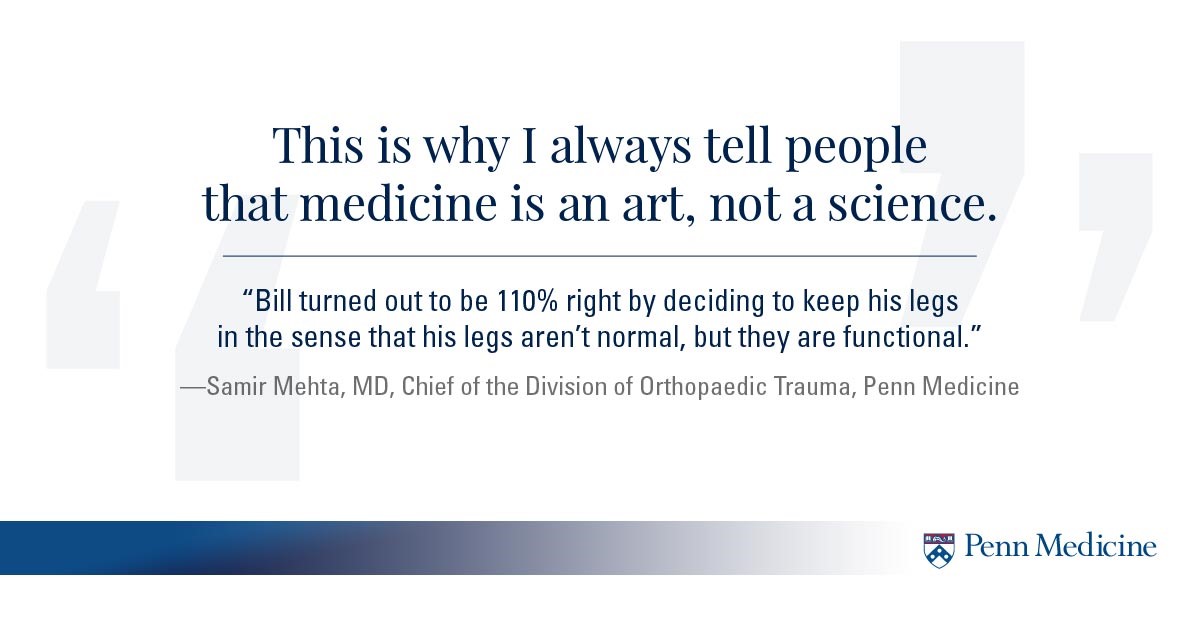“I thought I was going to be on disability for the rest of my life. I didn't think it would be smart for me to have children if I couldn't work full time. But I can do that, and it's all because of him. His whole team at Penn was unbelievable.”
Bill Minnis pictures with his wife, Jessica, and daughters, Adrianna and Gia
Source: Bill Minnis
After an evening out with friends, Bill Minnis, 24, was the designated driver. His car was rear-ended as he was exiting I-76. "We went through a guardrail, and the guardrail sliced open the bottom of my car, which cut off the brakes and any steering capabilities, he explains. "We went right into a wall, and my legs were exposed underneath the vehicle. From the knees down, everything was pretty mangled."
Over the next couple of years, Bill's willpower would be tested as he fought to get his life back. Several rounds of orthopaedic surgery by Samir Mehta, MD, chief of the Division of Orthopaedic Trauma at Penn Medicine taught Bill never to give up.
Surviving The Accident
Immediately after the crash, Bill's friends carried him up the hill away from his car. Thankfully, one of them was a nurse who had the foresight to use his shirt to tie Bill's legs together.
Though Bill was in shock from the pain, he does remember that as soon as the ambulance arrived, his car blew up.
Once he made it to Penn Medicine, no one was sure if he would survive, let alone keep his legs. "Apparently, my left foot was completely turned around, and my right foot was hanging on by a thread."
"They took me in and asked me if I wanted to talk to a priest or any religious person," he adds. "I don't remember much after that, but the next day I found out I was in surgery for six hours or so. Thankfully, Dr. Mehta was the doctor on call that night."
Enduring One Orthopaedic Surgery After Another
Dr. Mehta remembers when he first saw Bill in the emergency room around 2 a.m. His initial reaction was that Bill would lose at least one of his legs.
"Early in his care, we discussed amputation," Dr. Mehta recalls. "But he was a young guy and we wanted to do everything we could." Bill ended up spending more than a month in the hospital. During that time, he underwent more than a dozen operations — almost one every other day — because he had so many different injuries. "As soon as the anesthesia was leaving my body, I was back in the operating room," he says.
He had multiple compound fractures, the kind that involve bone poking out of the skin. "There were also infections from my feet and ankle wounds being exposed to dirt, grass and oil from the car accident."
Bill eventually started to believe he would recover, and he attributes that to Dr. Mehta's attitude. "He was very upfront and honest, but at the same time, his bedside manner was always one of confidence," he says.

Persevering Through Recovery
On May 3, 2010, Bill was discharged from the hospital. But his road to recovery was just beginning. "It was a long, long recovery," he recalls. "I spent almost two and a half years out of work. I lived in a makeshift room in my parents' dining room — which was a nightmare for me, as a 25-year-old. I was confined to a wheelchair, walker, crutches and cane."
For the next two years, Bill worked to regain his independence: He went to rehab about three times a week and was finally able to put weight on his feet. "The pain was just unbearable," he explains. "Apparently, my cartilage was gone. It was like I was walking bone on bone, with zero cushioning inside my lower extremities."
After exploring different options to help Bill maintain his mobility without extreme pain, Dr. Mehta finally decided on dual ankle fusions.
"I have zero range of motion in both feet and I wear a prosthetic on my right foot," Bill adds. "It sounds terrible, but it could have been a lot worse. I really should not have either my left foot or my right leg from the knee down."
Exceeding Expectations
Bill hasn't needed a wheelchair, crutches, or cane for a few years now. He has adapted to the prosthetic and the inability to move his feet. He goes to the gym four times each week and does more than a mile on the elliptical. He's also picked up golf.
"Dr. Mehta's given me the ability to live my life," Bill says. "He left it on my shoulders to be able to become a man — which I really didn't think I was going to be able to do. I got married. I danced with my wife and mother at my wedding. And now, I have twin daughters who are two and a half years old. I can play with them. I can hold them, carry them and do everything I didn't think I would be able to do," Bill says. "It was a long, long recovery, and it's something I'll deal with for the rest of my life. But I really owe Dr. Mehta for everything he's done," he adds. "I thought I was going to be on disability for the rest of my life. I didn't think it would be smart for me to have children if I couldn't work full time. But I can do that, and it's all because of him. His whole team at Penn was unbelievable."
Now 30 years old, Bill says he cannot thank Dr. Mehta enough. "I have no idea why that accident happened to me, but I thank God that it was Dr. Mehta who was on call that night. I don't know where I'd be mentally, emotionally and physically without his efforts and his genuine care."